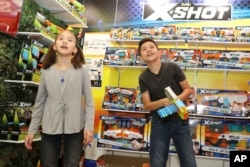There was plenty of slime and llamas in red pajamas at the International Toy Fair earlier this week in New York. Hidden among these popular playthings were a number of toys that cater to the modern-day kid, with plenty of technology built in.
Educational toys are a mainstay in the industry, and S.T.E.M. toys, those that incorporate principles of science, technology, engineering and math, have garnered attention in recent years. But now, toymakers are addressing children’s emotional intelligence as well, with toys that not only cultivate their IQ but their EQ, or emotional quotient.
PleIQ is a set of plastic toy blocks that use augmented reality technology to showcase a variety of words, numbers and lessons to children. PleIQ CEO Edison Durán demonstrated how virtual characters and miniature storybook scenes pop up on the blocks when they’re held in front of a tablet camera.
“Every side of a block, every letter, every number and every symbol becomes a 3-D interactive learning experience especially designed to foster the multiple intelligence of preschoolers,” Durán said.
Intelligence here includes intrapersonal and interpersonal skills, and PleIQ builds on these by having kids play the role of teacher or guide.
“The children have to help the companion character in (a) difficult situation. So they have to give them advice to solve these situations that are common,” Durán said.
‘A kid’s Alexa’
On the other side of the convention center, Karen Hu was demonstrating the workings of an educational robot called Woobo.
“You can think of this as a kid’s Alexa,” said Hu, Woobo’s strategic partnerships and business development manager. “We have a lot of expressions that’s built into it.”
Hu posed a question to the furry green Woobo, “Hi, what’s your name?”
It responded in a childlike voice with, “Are you trying to trick me? My name is Woobo.”
Woobo comes programmed with educational games and activities that children can access via its touchscreen face. Toys that function as companions also aid in social development. Hu described how Woobo can help an autistic child.
“He can communicate with Woobo and he can follow some of the instructions Woobo is giving,” said Hu, noting that kids see Woobo more as a companion than a parent or authority figure “telling him to do certain things.”
Stress-relieving animals
A more low-tech companion is Manimo, toy animals weighing 2.2 to 5.5 pounds that can help with hyperactivity and concentration. Whether it’s a snake, salamander, dolphin or frog, Manimos can be draped across a child’s arm, chest or neck.
Like the use of weighted blankets or vests in occupational therapy, Manimos alleviate anxiety and stress and can be particularly helpful to kids with attention-deficit hyperactivity disorder (ADHD) or those on the autism spectrum.
Karine Gagner, president and founder of Manimo, explained that applying deep pressure to one’s body can help calm kids before bedtime, while simultaneously increasing their concentration and focus.
“It works very well at school, you can use it on your lap or you can put it over your shoulder or just hold it in your arm,” Gagner said.
Social intelligence
At the EQtainment booth, sales director Jonathan Erickson was explaining the company’s toy lineup: “The purpose of all of our products is to develop emotional and social intelligence in kids — so that’s impulse control, manners, any skill sets relating with other people.”
“It doesn’t matter if you’re a genius when it comes to IQ, you still need to be able to relate with the world around you,” Erickson said.
Erickson was displaying a board game called “Q’s Race to the Top,” in which players try to advance a monkey named “Q” to the top of his treehouse while engaging in an interactive mix of physical activity and conversational prompts. Kevin Chaja, EQtainment’s CTO, says the game got his 4-year-old daughter to open up.
“The biggest thing, is her talking. And that’s the key of all this, is getting her to talk, getting her feelings expressed out. Like, ‘Hey, what does it feel like to be sad? Or how does it feel like to be happy?’” Chaja said.
Whether a board game can ultimately improve a child’s emotional intelligence remains to be seen, but in parents’ ongoing quest to raise well-rounded children, toymakers are making sure to cover all their bases.






